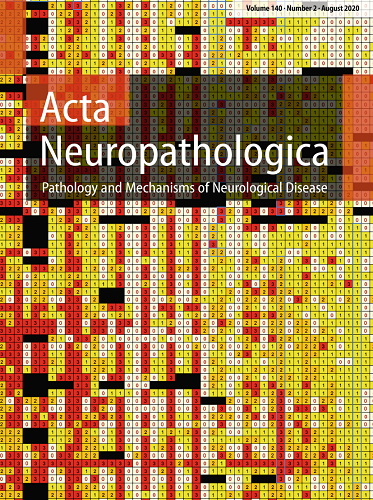遗传和蛋白质组学分析确定BAG3是神经元蛋白停滞的淀粉样蛋白反应调节因子。
IF 9.3
1区 医学
Q1 CLINICAL NEUROLOGY
引用次数: 0
摘要
自噬-溶酶体途径(ALP)和泛素-蛋白酶体系统(UPS)是维持神经元蛋白质稳态的主要蛋白质降解机制。然而,人类遗传变异对这些通路的影响和BAG3的作用知之甚少,特别是在阿尔茨海默病的背景下,其中蛋白质抑制功能障碍是一个决定性的标志。我们利用来自深度表型队列的大量iPSCs来询问遗传对人类神经元基线自噬通量和UPS活性的影响,并使用基于silac的定量蛋白质组学评估蛋白质周转。在这组神经元中,我们观察到自噬通量的显著个体间差异,这与UPS活性呈负相关。这种相互关系延伸到tau稳态,其中较高的自噬通量导致聚集磷酸化tau的积累减少。蛋白质组学分析显示,基于降解途径活性的全球蛋白质周转动力学分层,可以预测途径特异性底物依赖性。有趣的是,bcl -2相关的凋亡基因3 (BAG3)是伴侣辅助选择性自噬途径的重要成员,作为一种动态调节的自噬伴侣出现,对UPS和ALP的药物抑制都有反应。在神经元中,BAG3敲除降低了自噬通量,增加了高分子量磷酸化tau蛋白的水平。值得注意的是,家族性AD突变和Aβ暴露诱导神经元中BAG3的表达,而人脑组织中BAG3水平升高与更高的神经病理负担和疾病进展相关。我们的研究结果确定BAG3是人类神经元中蛋白质静止的关键调节剂。它在遗传背景和病理刺激中的调节表明,它在维持阿尔茨海默病和相关疾病的降解活动中起着核心作用。本文章由计算机程序翻译,如有差异,请以英文原文为准。
Genetic and proteomic analysis identifies BAG3 as an amyloid-responsive regulator of neuronal proteostasis.
The autophagy-lysosome pathway (ALP) and the ubiquitin-proteasome system (UPS) are the primary protein degradative mechanisms maintaining proteostasis in neurons. However, the impact of human genetic variation on these pathways and the role of BAG3 are poorly understood, particularly in the context of Alzheimer's disease, where proteostatic dysfunction is a defining hallmark. We utilized a large panel of iPSCs from deeply phenotyped cohorts to interrogate genetic contributions to baseline autophagic flux and UPS activity in human neurons, and protein turnover was assessed using SILAC-based quantitative proteomics. Across this panel of neurons, we observed substantial inter-individual differences in autophagic flux, which was inversely correlated with UPS activity. This reciprocal relationship extended to tau homeostasis, where higher autophagic flux resulted in reduced accumulation of aggregated, phosphorylated tau. Proteomic analyses revealed that global protein turnover dynamics stratified based on degradation pathway activity and could predict pathway-specific substrate dependencies. Interestingly, Bcl-2-associated athanogene 3 (BAG3), an important member of the chaperone-assisted selective autophagy pathway, emerged as a dynamically regulated autophagy chaperone, responsive to pharmacological inhibition of both the UPS and ALP. BAG3 knockout in neurons decreased autophagic flux and increased levels of high-molecular-weight phosphorylated tau. Notably, familial AD mutations and Aβ exposure induced BAG3 expression in neurons, while elevated BAG3 levels in human brain tissue were associated with higher neuropathological burden and disease progression. Our findings identify BAG3 as a key modulator of proteostasis in human neurons. Its regulation across genetic backgrounds and pathological stimuli suggests a central role in maintaining degradation activities in Alzheimer's disease and related disorders.
求助全文
通过发布文献求助,成功后即可免费获取论文全文。
去求助
来源期刊

Acta Neuropathologica
医学-病理学
CiteScore
23.70
自引率
3.90%
发文量
118
审稿时长
4-8 weeks
期刊介绍:
Acta Neuropathologica publishes top-quality papers on the pathology of neurological diseases and experimental studies on molecular and cellular mechanisms using in vitro and in vivo models, ideally validated by analysis of human tissues. The journal accepts Original Papers, Review Articles, Case Reports, and Scientific Correspondence (Letters). Manuscripts must adhere to ethical standards, including review by appropriate ethics committees for human studies and compliance with principles of laboratory animal care for animal experiments. Failure to comply may result in rejection of the manuscript, and authors are responsible for ensuring accuracy and adherence to these requirements.
 求助内容:
求助内容: 应助结果提醒方式:
应助结果提醒方式:


